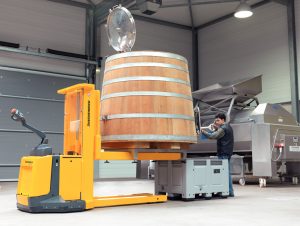
Gols. Visitors to the wine cellar of the Heinrich Winery in the Austrian state of Burgenland will witness a lot more going on there than just the frothy bubbling of fermenting grapes. They will also see the bustling activity of several Jungheinrich trucks which, together with gravity, provide for smooth logistics at the winemaking facility.
Once the Heinrich winery has completed the grape harvest, things really go into high gear. That is because the Heinrich Winery, located in the town of Gols in the state of Burgenland in eastern Austria, produces roughly 4,000 hectolitres of red wine annually – wines which are marked by their robust character and strong embodiment of the local terroir. The grape varieties at Heinrich consist primarily of Zweigelt, Blaufränkisch, St. Laurent and Merlot.
In and of itself, this would not set Gernot Heinrich apart from the other local vintners. But a look behind the scenes reveals that Heinrich has not only worked on the ideal solution to storing his wine – he has also given a great deal of thought to the logistical aspects.
Laws of Gravity
“When we started excavating a large area in back of our house, the neighbours thought we must be putting in a swimming pool,” he recalls wryly. But over time they could see that Heinrich was actually building a three-storey wine cellar, designed to serve as a combined production, storage and logistics centre for the vineyard’s outstanding red wines.
“Our wine cellar is ruled by the laws of gravity,” explains Heinrich. In practice this means the grapes are processed without the use of pumps, making it necessary to transport wine tanks back and forth between the different floors. To master this logistical challenge, Heinrich decided to employ Jungheinrich stackers.
From the Harvest to the Bottling
But before that, the grapes need to be harvested from the various vineyards belonging to the winery, after which they are transported to the wine cellar in boxes which can hold between 100 and 400 kilograms. Here they are placed on a sorting belt to pass through a de-stemming machine, separating the grapes from the stems and then gently plunking them down onto a second conveyor belt, before gravity induces them to fall into the wine tanks.
“Over the following weeks the grapes begin to ferment,” explains Heinrich, “and gravity sees to it that the resulting wine flows into wooden casks.“ To ensure the quality of the young wine and aerate it, the wine is frequently poured from one cask to another. “At the end of this process, to guarantee a homogeneous product, we then pour the wine from the casks back into the tanks, and from there into bottles,” says Heinrich. Once the bottles have been filled they are placed in crates, then stacked on pallets and brought to the storage area.
Several Jungheinrich trucks are needed to perform the logistics tasks at the winery, including EFG 220 and EFG 320 counterbalance trucks, assigned to transport operations in the storage area. These consist of 48 V battery powered stackers equipped with Jungheinrich three-phase A.C. technology, which allows them to achieve “top throughput rates thanks to their high standards in accelerating, driving and lifting,” comments Claus Hurst, Jungheinrich engineering consultant for Burgenland. This pays off particularly during peak times, when “all our stackers are in operation,” declares Heinrich – a time when rental trucks are even occasionally brought in as reinforcements, he adds.
The load handling attachment for the counterbalance trucks is pivoted, allowing the operator to tilt the boxes full of freshly picked grapes so gently they are not damaged when spilling out onto the sorting belt. The trucks also have recessed sections of the overhead guard, allowing them to be driven directly into the drive-in racks where the boxed and palletised wine bottles are stored.
“Drive-in racks are ideal for storing large, heavy quantities of goods when the variety of stored items themselves is small,” says Hurst. Jungheinrich drive-in racks have an open side for forklift access. These aisles are filled from the rear to the front, making additional access aisles unnecessary. “Both rack systems combine the advantages of block storage with rack storage, guaranteeing compact space utilisation and at the same time tall stacking heights and gentle handling of the stored goods,” relates Hurst.
Based on a total width of just 1,120 millimetres and the recessed areas in the frame of the overhead guard, the stacker can be operated quickly and safely in the aisles between the drive-in racks. It is designed for lift heights of over 7 metres and can transport payloads of up to 2,000 kilograms.
These counterbalance trucks are consequently not quite capable of transporting the winery’s mobile wine tanks, which can weigh up to 3,000 kilograms. But since the tanks need to be transported between the different storeys there, specially built trucks from Jungheinrich are required.
The task here consists of transporting heavy loads through narrow aisles to the freight elevator, so the Jungheinrich special build plant in Lüneburg, Germany, designed heavy-duty electric platform trucks with standard drives, but a specially designed load section.
Functionality and Quality More Important than the Price
“Special built products are always going to be a tad more expensive,” explains Gernot Heinrich, “but they are necessary and we want them!” Needles to say, he adds, price originally played a role when Heinrich ordered its first Jungheinrich stackers over ten years ago.
But functionality and quality are more important than the price on paper, he continues. “And Jungheinrich has more than met our requirements in those areas – not to mention the excellent fittings and ergonomic design of their trucks.”
jak – 2008